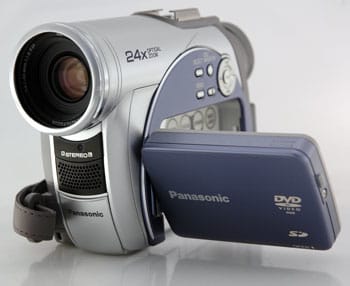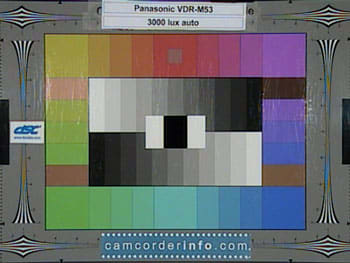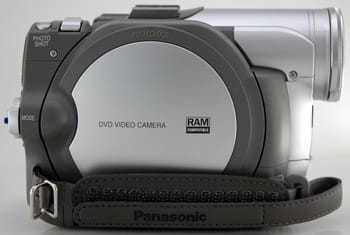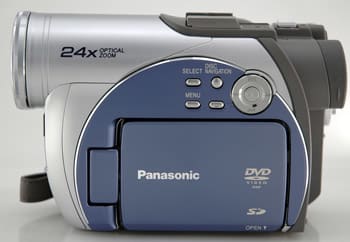Pros
Cons
Intro

Performance
**Video Performance ***(6.5)*
The VDR-M53 is equipped with a 1/6", 680K CCD. This CCD has 340K effective pixels for both video and still capture. Panasonic’s VDR-M50 of last year had similar imaging specs and did okay, not as well as last year’s Hitachis, but good, especially compared to last year’s Sonys.
At 3000 lux, the VDR-M53 does really well. It shows good colors with incredible crispness. The magenta tile looks kinda odd, different that the color usually represented on camcorders. The image is equal to the VDR-M75 in nearly every criteria, with the VDR-M75 perhaps a tad crisper. But, overall, the better imager of the VDR-M75 only really comes into play in lower light environments. Compared to last year’s VDR-M50, the VDR-M53 produces better, crisper, richer colors in bright light.
Compared to some MiniDV camcorders the VDR-M53 does surprisingly well in bright light environments, though not so much in the low. It produces video at 3000 lux on par with the PV-GS35 and the DCR-HC32, easily.

Video Resolution* (10.5)*
In order to calculate the VDR-M53’s video resolution, footage was taken of a standard resolution chart, and stills from this video were exported to Imatest Imaging Software. At its best, the camcorder produced approximately 367.5 lines of horizontal resolution, and 286.3 lines of vertical resolution, yielding a resolution of 105215.25 (0.105 MP).
Still Performance*(6.0)*
Still performance on the VDR-M53 is excellent. Its colors are brilliant, deep, and rich, even compared to some 3 chip camcorders, including Panasonics. In fact, the VDR-M53’s brilliant gray scale is much more brilliant than the DCR-PC1000’s. And, furthermore, there isn’t much of a difference between the spectra of the PV-GS250 and the VDR-M53 aside from the three-chip's superior crispness. However, the VDR-M53 does show some significant blue noise in the violet/blue side of the spectrum. Usually, we've only seen this noise on certain Sony camcorders. Looks like it's spreading.
Still Resolution*(3.46)*
The Panasonic VDR-M53 can capture stills onto SD card and DVD discs at 640 x 480. Exporting stills from a standard resolution chart allowed us to test the camcorder’s still resolution. At its best, the VDR-M53 generated 346800 (0.346 MP) lines of still resolution.

Low-Light Performance*(3.0)*
The low light performance of the VDR-M53 is quite disappointing. We tested the camcorder at our regular light levels of 60 and 15 lux. Sixty lux is the approximate equivalent of a slightly dimmed indoor office, by no mean indiscernible to the human eye. Fifteen lux is definitely darker though still within range of the manufacturer’s acceptable illumination and very much accessible to the human eye.

While at sixty lux, the VDR-M53 produced video that slightly darker than last year’s VDR-M50 results, its colors were crisper and more balanced. There was some nasty noise in the magenta tile at sixty lux, but the main problem occurs at 15 lux. At 15 lux the camcorder loses almost all of its color information, and while it does show a dramatic reduction of noise from last year’s model, both images are really unusable.
Also, at these lower light levels, the improved CCD of the VDR-M75 comes into play giving this more advanced camcorder the edge at both 60 and 15 lux, where it is able to retain some color information. Both camcorders have equal amounts of noise.

Compared to some MiniDV camcorders, the VDR-M53 cannot compete as well as it did at brighter light levels. While it maintains lower noise levels than some of these camcorders, it also severely suffers in the noise department.
Wide Angle*(8.4)*
The Panasonic VDR-M53 produced a wide angle measurement of 42 degrees with the zoom pulled completely out.

LCD 4:3 standard aspect
Format
Compression*(5.0)*
The Panasonic VDR-M53 uses MPEG2 video compression with JPEG still images.
Media*(5.0)*
The Panasonic records to DVD-RAM and DVD-R discs. It also records stills to SD/MM.
Editing*(3.0)*
Editing on DVD camcorders and with DVD media is difficult, and the user gains much more editing compatibility by using MiniDV tape. The DVD formats can usually be rudimentarily edited using the on-camcorder options or the supplied software, but all in all these options are jokes compared to the versatility that MiniDV gives you.
Tour
**The Front ***(6.0)*
The front side of the VDR-M53 is pretty standard. Lens barrel on top, with a port cover on the bottom, in this case covering the camcorder’s A/V input/output and microphone input, and a built-in stereo microphone in between.

**

The Right Side ***(7.5)*
The right side of the VDR-M53 features the camcorder’s DVD mechanism, strap, and not much else. The DVD mechanism, which now supports DVD-RAM discs without plastic coverings (last year’s camcorders required them), takes up most of the side, and the strap snakes its way along the bottom. While much of Panasonic’s DVD line this year has undergone cosmetic changes, however minor, Panasonic’s skinny strap seems to always stay the same. If you have big hands this strap can be great as it is very long, but if your hands are small it can pose a problem as it is not as comfortable as other faux-suede straps.
**

The Left Side ***(7.0)*
The left of side of this camcorder is its main control center. Not only does it feature the camcorder’s main visualization source, its 2.5 inch LCD screen, but also a group of buttons governing what little manual control the camcorder has, and the navigational buttons necessary for surfing the camcorder’s menu system.
While the functions of the various buttons outside of the LCD screen’s cavity have not changed over the last year--there are still buttons for Disc Navigation, Menu, Select, Stop, and a four-way navigational button—button placement has changed. Instead of a column of buttons running down the right side of the LCD screen, these buttons form a neat cluster on the upper edge. The new navigational button is a bit harder to use than last year’s small nub device, but it’s not too hard.
The buttons underneath the LCD have not changed place or function from last year’s model. There are still buttons for auto mode, focus, exposure, back light, display, and two volume/adjustment buttons. Also under the LCD is the camcorder’s SD/MM card port, having been moved from the right side. The USB port found on last year’s VDR-M50 has been removed from under the LCD screen on the VDR-M53, and indeed has been removed from the camcorder completely.
**The Back ***(5.5)*
The back of the VDR-M53 features the camcorder’s mode dial, color viewfinder, and DVD mechanism open switch. The battery slot is also located here. The mode dial has options for recording movies to disc, stills to disc, stills to SD card, and off. The camcorder’s record button rests in the middle of the mode dial. The viewfinder will extend about a half an inch towards the viewer.

The Top*(7.0)*
The top of the VDR-M53 features the camcorder’s cold accessory shoe, crummy zoom toggle, and photo button. Kinda sparsely populated up here.

Auto / Manual Controls
Picture & Manual Control
Automatic Control (6.5)
The Panasonic VDR-M53 features automatic controls over exposure, focus, and white balance, and also includes an Auto mode which locks these features in their respective automatic settings. The button for auto mode is under the LCD screen. In auto mode, white balance and the camcorder’s Program AE settings are locked. In order to get out of the full auto mode, the user can press the auto button again, or press either the focus or exposure button.
As far as automatic performance goes, the VDR-M53 is okay. While focus and exposure adjustments aren’t as accurate as on many Sony camcorders, they do pretty well at the camcorder’s widest angle. At full telephoto things are different, though understandably so. The focus lags tremendously as it searches for itself, and exposure has a hard time adjusting as well. White balances adjustments are surprisingly quick and accurate.
Overall Manual Control (3.0)
There are not many real upgrades on the manual controls found on the Panasonic VDR-M53. If anything this camcorder represents an effort by Panasonic to strip down its DVD camcorders from last year, in order to compete cost-wise with the many cheaper DVD camcorders released this year.
While manual control hasn’t been stripped down, it has remained very static. It has the same basic manual controls of focus, white balance, and a bundled iris and shutter speed control, labeled ‘exposure’. Both focus and exposure are located and operated by cumbersome devices and really shouldn’t be relied upon for anything. White balance is probably the most useful manual control offered.
Zoom (7.0)
The zoom control on the VDR-M53 isn’t too bad compared to some of the zoom toggles found on Panasonic’s MiniDV camcorders, though it’s still very mediocre. The good news is that its placement is perfect, directly underneath the user’s index finger. It also has little crenelations which make control a bit easier, though the device isn’t exactly the smoothest toggle on the market today.
*Zoom Power/Ratio(24.0) *
The VDR-M53 has an optical zoom of 24x— pretty impressive, though in line with the trend among DVD camcorders of lower-end camcorders having higher optical zooms. There are also digital zoom options of 60x and 800x.
*

Focus (3.5)*
Manual focus is controlled by way of a button under the LCD screen. Once pressed, this button shows an "MP" icon on the LCD screen, and the volume buttons, also under the LCD screen, can be used to adjust focus. There is no other visualization of this process other than the image on the LCD screen, which makes manual focus more of a hassle to use than any other control on this camcorder.
Exposure (Aperture) (4.0)
Exposure is operated in a similar way to focus on the VDR-M53, except adjustments are made along a +/- meter. While this meter offers a way to visualize the changes that the user makes, it’s still not the best, and certainly a far inferior option to the independent shutter speed and aperture controls on nearly every MiniDV Panasonic camcorder.
*Shutter Speed (0.0) *
There are no manual shutter speed controls on the VDR-M53.
White Balance (6.5)
Perhaps the most useful manual function on the VDR-M53, white balance is accessible using the camcorder’s menu system. With this placement, the control is squirreled away and relatively hard to get to. That said, white balance shouldn’t necessarily have to be used on the fly, making this out-of-the-way positioning understandable. Along with manual set and auto functions, users can also select from indoor and outdoor presets, which place limits on the camcorder’s automatic white balance’s window of performance.
Gain (0.0)
There is no manual gain control on the VDR-M53.
Other Manual Control (0.0)
There are no other manual controls on the VDR-M53.
Still Features
Still Features*(5.5)*
The main impressive still feature on the VDR-M53 is the sheer number of stills it can capture to a DVD disc, something that all DVD camcorders can boast about. Probably the least advanced still-wise, of all the DVD camcorders, the VDR-M53 captures stills to SD/MM card or DVD-R/RAM disc at a single size of 640 x 480. The still camera mode’s menu system is almost exactly the same as the video camera’s, and offers no choice of quality or any other still options. Focus and exposure controls can be used when recording still images.

Handling and Use
Ease of Use*(4.5)*
The VDR-M53 is easy to use as long as you keep the camcorder in full auto mode. This is because all of the camcorder’s manual controls are hard to reach, either under the LCD screen or within the menu system. If you don’t need to enter the cumbersome menu system or LCD button cluster, you’ll be fine. The VDR-M53’s menu system, unlike that of many of Panasonic’s MiniDV camcorders, hasn’t been redesigned, and as it turns out, this is for the worse.
**Handling ***(6.0)*
The VDR-M53 handles pretty well for the least advanced DVD camcorder on the market this year. Its strap is narrow and doesn’t get in the way, yet it’s wide enough to accommodate a wider hand. Its zoom toggle also rests directly beneath the user’s index finger. Both of these aspects make the camcorder a nice handheld device. The LCD screen does solarize when viewed from an angle, however, which takes a little away from the versatility of the machine. Another problem is that the camcorder’s viewfinder only extends directly backwards about a half an inch. While this wouldn’t be a big problem on its own, the camcorder’s battery also protrudes from the back of the machine. As it is the viewfinder cannot really be used comfortably.

Portability*(6.0)*
As opposed to some of Hitachi’s DVD camcorders this year (Hitachi and Panasonic DVD camcorders of last year looked almost identical), Panasonic hasn’t made their DVD camcorders much smaller this year, making them probably the least portable of all DVD camcorders, though DVD camcorders tend to all be around the same size. This camcorder isn’t any less portable than the DCR-DVD403.
LCD/ Viewfinder*(6.0)*
The VDR-M53 features a 2.5-inch LCD screen with approximately 120K pixels. The camcorder also has a 0.2-inch color viewfinder with 200K pixels. The LCD screen solarizes when viewed from an angle. It can be rotated 180 degrees counter-clockwise and 90 degrees clockwise.

**

Battery Life***(7.5)*
The VDR-M53’s included battery fares quite well with a recording time of over an hour (1 hr. 15 min. 25 sec.).
Audio / Playback / Connectivity
**Audio ***(6.0)*
The VDR-M53 does feature a microphone input, so decent audio can be captured if desired. Unfortunately, there is no intelligent accessory shoe so the mic will need to supply its own power. Audio playback format is MPEG audio layer 2.
**

VCR Mode ***(6.5)*
The VCR Mode on the VDR-M53 is particular. This model lacks a USB port, making footage captured on the DVD-RAM disc unavailable for direct computer editing manipulation. To get this footage onto the computer you must go through a DVD Video Recorder with a hard disk (Panasonic makes these). Also with these DVD Video Recorders you can make full size DVD-Rs with DVD-RAM footage.
DVD-R footage captured on the VDR-M53 can be reviewed on a conventional DVD player, but you’ll need a compatible DVD player to view DVD-RAM discs (Panasonic makes such players).
Using the composite jack, you can view footage on your TV using its A/V ports or S-Video port. Dubbing images from another device is also available using this cord.
Ports*(6.0)*
The VDR-M53 only has two ports: an A/V input/output port and a microphone input. It is one of the only DVD camcorders this year to lack a USB port. All DVD camcorders lack FireWire ports. There is also a cold accessory shoe and a SD/MM card slot on the camcorder.

Other Features
Widescreen/16:9 Mode*(0.0)*
Another big downgrade, but perhaps one that allows the VDR-M53 to maintain its "stripped-down and cheaper" status, is that the camcorder doesn’t have a widescreen mode. The VDR-M55, VDR-M75, and VDR-M95 all have widescreen modes.

Standard 4:3 aspect
Scan Rates/24P*(0.0)*
The VDR-M53 offers no alternate Scan Rates, 24P-like effects, or anything like that.
**Other Features ***(2.5)*
EIS The VDR-M53 features Electronic Image Stabilization. Not as good as optical, this stabilization also costs less. It can be turned on or off in the video camera mode’s menu system.
Disc Navigation This feature, usually available on DVD camcorders that record onto DVD-RAM discs, allows for extremely easy and convenient on-camcorder visualization, as well as presenting options for rudimentary editing and effects.
Comparisons / Conclusion
Comparisons
Panasonic VDR-M55, VDR-M75, and VDR-M95
As the VDR-M53 is the least advanced of the Panasonic line, it is expected that the VDR-M55, VDR-M75, and VDR-M95 are all more advanced. But how advanced, you ask, and at what cost. Well, let’s just say that if you buy the VDR-M75 or VDR-M55 you’ll receive the absent USB, remote controller, and included software of the VDR-M53. The big difference between the VDR-M55 and the VDR-M75 is that the VDR-M55 keeps the same imager as the VDR-M53, while the VDR-M75 upgrades to a 1.33 MP CCD (690K for video, 1.1 MP for stills). Also, the VDR-M55 maintains the VDR-M53’s 24x optical zoom, while the VDR-M75 drops to a 10x. The VDR-M75 captures stills at 1280 x 960 while the VDR-M55 maintains the VDR-M53’s mediocre 640 x 480.
And how does the VDR-M95 fit into all of this? Well, it upgrades the imager further to a 2.12 MP CCD (1.23 MP for video, 1.92 MP for stills), captures stills at 1600 x 1200, and has a 10x optical zoom. As far as pricing goes, the VDR-M75 is about two hundred dollars more than the VDR-M53, with the VDR-M95 over two hundred dollars more than that.
Sony DCR-DVD92
While this year’s Panasonic DVD camcorders haven’t undergone the drastic cosmetic changes that Sony’s entire line (except the DVD301) has, it has basically the same hardware and specs as the DCR-DVD92, Sony’s comparably-priced, lowest-end DVD camcorder. Both camcorders are armed with a similar CCD (680K), lack USB ports, and have 2.5" LCD screens. The Sony has the company’s touch screen technology which doesn’t really add too much to the camcorder’s functionality. The VDR-M53 has a 24x optical zoom while the Sony has a 20x optical. The salient difference here is the fact that the Sony records to DVD-RW/+RW, while the Panasonic records to DVD-RAM (both record to DVD-R). This gives the Sony a bit more versatility, especially when on-computer manipulation is concerned, as both camcorders lack USB interfaces. Another big difference is that the Panasonic can record stills to SD/MM card, while the Sony can only record them to disc. On a superficial note, the Sony looks a lot cooler, as it features the taser-esque design of its siblings.
Who It’s For
Point-and-Shooters *(7.0)*
With little and cumbersome manual control, this camcorder is definitely for point-and-shooters, though perhaps not as easy to use as some of the Sony DVD camcorders.
Budget Consumers*(9.0)*
As far as DVD camcorders go, this is the cheapest.
Still Photo / Video Camera Hybrid*(6.5)*
This guy captures stills at 640 x 480, and that’s it. It can take a bundle of stills to disc though and gives you the option of recording to card. The still quality is a pretty awesome though.
Gadget Freaks*(2.0)*
Aside from the DVD factor, this guy is pretty devoid of all gadgets.
Manual Control Freaks*(2.0)*
Not a manual control camcorder at all. Look to those Panasonic MiniDV camcorders for that. You can probably get a pretty good one for around the same price.
Pros/ Serious Hobbyists*(2.0)*
No, DVD camcorders are for point-and-shooters on family vacations, looking for convenient, gimmicky compatibility.
Conclusion
At this point, I’m really interested to see how the DCR-DVD92 performs. Sony’s DCR-DVD403 performed unbelievably, and while it has a vastly superior imager to the DCR-DVD92—indeed, the DCR-DVD92 has the same image as some of Sony’s horrendously performing DVD camcorders of last year—if Sony’s improvement can improve from last year, the DCR-DVD92 might be able to show the VDR-M53 some competition.
As the cheapest DVD camcorder aside from the DCR-DVD92, the VDR-M53 should be popular even though it lacks some compatibility features. If its video performance proves better than the DCR-DVD92’s (and it very well could), it could become one of the better DVD buys this year. That said, Sony has made some compatibility advancements (DVD+RW available), while Panasonic has remained static when they should have at least made the camcorder DVD-RW accessible. Anyway, we’ll see; if the Sony’s performance stays the same, the VDR-M53 might not have to worry too much about compatibility.
One of the main downsides to this camcorder is its bad low light performance; however, considering the lack of manual control on this thing, buyers will probably be buying this machine for its bright light, point-and-shoot capabilities, and with such good bright light performance, it’s hard not to call this a good buy already.
Meet the tester

Matt Culler
Editor
Matt Culler is a valued contributor to the Reviewed.com family of sites.
Checking our work.
Our team is here to help you buy the best stuff and love what you own. Our writers, editors, and experts obsess over the products we cover to make sure you're confident and satisfied. Have a different opinion about something we recommend? Email us and we'll compare notes.
Shoot us an email